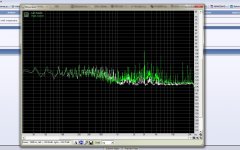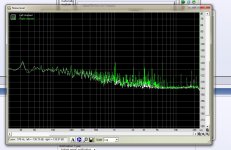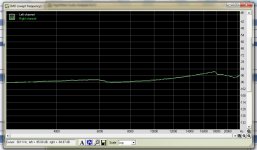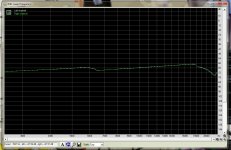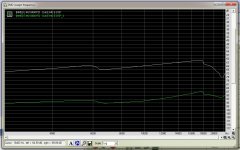Strange.....
My Altec 291 drivers (on 803 horns) are roughly as sensitive as the 909s. I hear NO hiss at all from the stock DCX outputs - unless I put my ear right up to the horns.
I'm running attenuation in front of the amp (volume control) and after the amp (L-Pad) to keep the levels reasonable. The DCX outputs are set to +3dB.
Are you running straight from your DCX into the amp? Any attenuation or volume control before our after the amp?
My Altec 291 drivers (on 803 horns) are roughly as sensitive as the 909s. I hear NO hiss at all from the stock DCX outputs - unless I put my ear right up to the horns.
I'm running attenuation in front of the amp (volume control) and after the amp (L-Pad) to keep the levels reasonable. The DCX outputs are set to +3dB.
Are you running straight from your DCX into the amp? Any attenuation or volume control before our after the amp?
Wow - someone with stock unit should do a THD&N measurement over frequency then...
Thanks, Cobra2 .
Michael
This measurement is on my list of things to do. Just need more hours in a day to get caught up on all the actively running projects - audio, home improvement, race car, day job...
Gary
Wow - someone with stock unit should do a THD&N measurement over frequency then...
Thanks, Cobra2 .
Michael
THD% has been measured over frequency already in that many times mentioned Germany test: Google Käännä
The THD% keeps constantly below (big deal) 0,01 and does not vary between 20hz - 20 000hz as you can see from the first picture from light blue/turqoise line from previous link. There has spread some rumour (based on flawed measuring) that DCX would add THD% in the high frequencies, but obviously this is not the case. (underlined so that this misconception would go away)
I have measured DCX with RMAA using E-MU 0404 PCI sound card (DAC = AK4395). Result were very good when comparing to E-MU. I tested it with two 1m (3,3 feet) long good RCA cables.
For some reason I always get 10dB worse Noise level with everything (incl: E-MU 0404, E-MU 1212M, E-MU 1616). I have tested all these cards and compared my result to the various test that are on the net, and always the same. With my setup noine of the cards don't achieve the same values as they have achieved in other valid tests. Maybe the PSU and Graphics card inside the PC that are very near the sound cards tend drop the DR and raise noise. There is an unexplained peak with both DCX and EMU in 3kHz, although DCX is not inside my computer
Keeping in mind that these measures do not make justice for either of the measured candidates, the measured noise level is:
E-MU: -106,4dB
DCX: -96dB.
If I add 10dB to both they are they very near the specs that the manufacturer promises (DCX: 109dB and E-MU: 116dB). With E-MU I naturally need only one metre of cable from outputs to inputs, that might explain some of the "extra 3dB" with DCX comparing to E-MU.
Other values:
THD%:
E-MU is 0,0008%
DCX 0,0083%.
IMD% + noise:
E-MU: 0,0025
DCX: 0,010%
With the results from that Germany test and these measurements you can deduct the THD% + noise, at least somehow. It does not vary greatly over frequency, and is actually quite good. The promised 109dB dynamic range and -109dB noise are achievable, and THD% + noise would then be something like 100 - 105dB maybe? Maybe you can estimate it better.
If you paste some of your results please paste alse the result of the sound card that was used in measuring.
Attachments
Last edited:
Hi Legis RCA asymmetric connects is not the best to use for precise measuring - change to symmetric and you will most certainly get more reliable results. Also - depending on balanced versus mere complimentary out, you waste some dB in S/N with asymmetric operation due to different summing of correlated and uncorrelated signals.
Anyway - the linked AP measurements are flawless and do not indicate *any* noise that's worth a mod (reflecting my own feeling back then too).
Wonder what Arne possibly has overlooked or if there are such differences in DCX samples, which is hard to believe ...
Lets wait what Gary will come up with.
Michael
Anyway - the linked AP measurements are flawless and do not indicate *any* noise that's worth a mod (reflecting my own feeling back then too).
Wonder what Arne possibly has overlooked or if there are such differences in DCX samples, which is hard to believe ...
Lets wait what Gary will come up with.
Michael
DCX(full analog output volume)->PowerAmps(LM3886)->Altec 515-8G-HP(x4) + Altex 909-8B(x2)
Hmmmm.... OK. So no attenuation between the DCX and the amps? None after the amps.
That setup does not work for me here. Too noisy in my rig.
My signal flow is like this:
- AES digital in / 0dB gain.
- Low Out - stock DCX pins 1 & 2. ->IcePower amp with stepped attenuator. ->Altec 416A
- Mid out - Transformer on AKM chip +4dB digital gain. -> Stepped attenuator on Tripath TA2024 amp -> L Pad ->Altec 291 driver
- High out - Transformer on AKM chip +3dB digital gain. -> Volume pot on Tripath TA2024 amp. -> Heppner horn tweeter.
The reason I use an L-Pad on the mid horns is for S/N ratio. The L-Pad allows me to drive the midrange amp hot enough to keep up "out of the dirt". The damping offered by the L-Pad doesn't hurt, either.
I think I need an L-Pad on the tweeters, there is some noise there. It comes from the amp, not the DCX.
The reason for the volume control on the amps is to adjust level. I need so little gain that the DCX signal must be attenuated before hitting the amps. It also keeps the DCX outputs up "out of the dirt" for better S/N. For general listening the output VU meters run about 1/2 scale, or more.
A typical log pot has about 20dB attenuation at mid scale - 12:00. If I can use that, I've just gained 20dB S/N.
There has spread some rumour (based on flawed measuring) that DCX would add THD% in the high frequencies, but obviously this is not the case.
Well my measurements certainly showed rising distortion on the stock DCX outputs. THD is less useful than looking at the harmonics themselves. In dual-tone and multitone tests, it's obvious that the stock output circuit contains more distortion at the high frequencies.
It will be interesting to see what Gary finds.
My signal flow is like this:
- AES digital in / 0dB gain.
- Low Out - stock DCX pins 1 & 2. ->IcePower amp with stepped attenuator. ->Altec 416A
- Mid out - Transformer on AKM chip +4dB digital gain. -> Stepped attenuator on Tripath TA2024 amp -> L Pad ->Altec 291 driver
- High out - Transformer on AKM chip +3dB digital gain. -> Volume pot on Tripath TA2024 amp. -> Heppner horn tweeter.
How do you do overall volume? I can't imagine you adjust each of the amps individually every time you want to change the volume...
Gee Sy, that's what the menehunes are for. 
It's a good question, actually. I use the volume control in my media player. The volume is done in the software at 32 bits, then output at 16 or 24 bits as I choose. It seems to work well - and I use ASIO drivers. So far, I have not been able to measure or hear any bad effects doing it this way. Gain structure is set so that most tracks play at 60-75% of the player volume. Classical tracks get 100% as the average level is lower.
One could use a 6 gang volume control after the DCX. I have a 6 gang motorized ALPs and some multi-gang stepped attenuators. So far, I have not felt the need for them.
It's a good question, actually. I use the volume control in my media player. The volume is done in the software at 32 bits, then output at 16 or 24 bits as I choose. It seems to work well - and I use ASIO drivers. So far, I have not been able to measure or hear any bad effects doing it this way. Gain structure is set so that most tracks play at 60-75% of the player volume. Classical tracks get 100% as the average level is lower.
One could use a 6 gang volume control after the DCX. I have a 6 gang motorized ALPs and some multi-gang stepped attenuators. So far, I have not felt the need for them.
In dual-tone and multitone tests, it's obvious that the stock output circuit contains more distortion at the high frequencies.
If you refer to some measurements or represent some arguments, please back it up accordingly.
On what measurements this statement is based on, could I have a link?
Basen on my measurements the IMD% varies like this (test is called "IMD% + noise (swept freqs)".
First is result of EMU, then result of DCX, then combined in same graph.
Yes there's little tendency that IMD% + noise rises slightly towards high frequencies, but so it is with E-MU. Someone must show us a better result with some modded DCX before we can conlude that stock DCX performs bad in this regard. I would be interested to see this test done on modded DCX. If you do please use RMAA so we have diagrams that are easily comparable.
Edit: And don't forget that some of the risign towards high frequencies is due E-MU itself.
Attachments
Last edited:
Alternatively, one can put a digital preamp before the DCX. The Meridian 518 (oldschool 48khz gear but with 72bits internal volume control) does wonders in this area
This is exactly what I have been thinking (also). Do you know any other digital preamps? They seem to be very rare.
If you refer to some measurements or represent some arguments, please back it up accordingly.
On what measurements this statement is based on, could I have a link?
Sorry Legis, I thought you had been following the thread.
They are right here, just a few page back.
http://www.diyaudio.com/forums/multi-way/15943-behringer-dcx2496-digital-x-over-238.html#post2051044
Sorry Legis, I thought you had been following the thread.
They are right here, just a few page back.
http://www.diyaudio.com/forums/multi-way/15943-behringer-dcx2496-digital-x-over-238.html#post2051044
That link needs fixing- it just returns to this page. I'll leave editing it as an exercise for the poster.
Also, you may have posted this before, but I'll ask anyway: you're doing volume control at the source using your media player. Which one are you using?
Thanks SY, I fixed the link.
I use JRiver as my media player. Not perfect, but the best fit for me I've found after years of using others. It's the user interface that I like - and the library management. The JRiver player has the option of doing volume control internally or thru the windows mixer (or not at all.) Since I use ASIO drivers, the internal option is good for me.
I stumbled on JRiver last year looking for a way to control a media player via a handheld device (Pocket PC). iTunes and the iPhone can do this, but I'm not crazy about iTunes and don't own an iPhone or iPod. There are a few 3rd party apps that will control JRiver from a handheld. So I've been happy with it.
FYI - I use the JRiver "Jukebox" which is the free version. It does only music, but that's all I need.
I use JRiver as my media player. Not perfect, but the best fit for me I've found after years of using others. It's the user interface that I like - and the library management. The JRiver player has the option of doing volume control internally or thru the windows mixer (or not at all.) Since I use ASIO drivers, the internal option is good for me.
I stumbled on JRiver last year looking for a way to control a media player via a handheld device (Pocket PC). iTunes and the iPhone can do this, but I'm not crazy about iTunes and don't own an iPhone or iPod. There are a few 3rd party apps that will control JRiver from a handheld. So I've been happy with it.
FYI - I use the JRiver "Jukebox" which is the free version. It does only music, but that's all I need.
Jumping in here, even though the question wasn't directed at me...
I'm pretty sure my source device puts out 16/48, which goes through the DAC, a selector switch (so I can use my turntable), and then into the DCX. Amps have level controls, and gain is set such that 0dB on the DCX input is more or less my average listening level. So I use the DCX input digital level control as my volume control, and generally find that +/- 6dB covers most of my music / moods.
At some point I might try getting rid of the DAC, and sending digital to input A, and maybe the phono stage to inputs B & C, and set up different routing profiles to switch between them.
I could replace my source selector with a passive attenuator, but I'm not sure if attenuating the analog input to the DCX will be better than digital attenuation after the ADC? My gut tells me it won't, but I haven't tested it.
I too had a lot of hiss when I first hooked everything up (horn tweeter). After adjusting gains such that the amps are turned down and the DCX outputs are flat / turned up, the hiss is gone, and all I hear is the amp's noise. I'll be switching to a less sensitive tweeter soon, and hopefully that should reduce the noise further.
I'm pretty sure my source device puts out 16/48, which goes through the DAC, a selector switch (so I can use my turntable), and then into the DCX. Amps have level controls, and gain is set such that 0dB on the DCX input is more or less my average listening level. So I use the DCX input digital level control as my volume control, and generally find that +/- 6dB covers most of my music / moods.
At some point I might try getting rid of the DAC, and sending digital to input A, and maybe the phono stage to inputs B & C, and set up different routing profiles to switch between them.
I could replace my source selector with a passive attenuator, but I'm not sure if attenuating the analog input to the DCX will be better than digital attenuation after the ADC? My gut tells me it won't, but I haven't tested it.
I too had a lot of hiss when I first hooked everything up (horn tweeter). After adjusting gains such that the amps are turned down and the DCX outputs are flat / turned up, the hiss is gone, and all I hear is the amp's noise. I'll be switching to a less sensitive tweeter soon, and hopefully that should reduce the noise further.
Hmmmm.... Interesting idea using the digital and analog inputs. I've done that briefly on the DEQ - it worked.
Hard to say if analog volume before the unit or digital volume inside the unit is going to be better. My wild guess is over the 12dB range you use, it won't be much different. As long as you drive the inputs to a good level.
You'll have to try it and let us know!
Hard to say if analog volume before the unit or digital volume inside the unit is going to be better. My wild guess is over the 12dB range you use, it won't be much different. As long as you drive the inputs to a good level.
You'll have to try it and let us know!
- Home
- Source & Line
- Digital Line Level
- Behringer DCX2496 digital X-over
